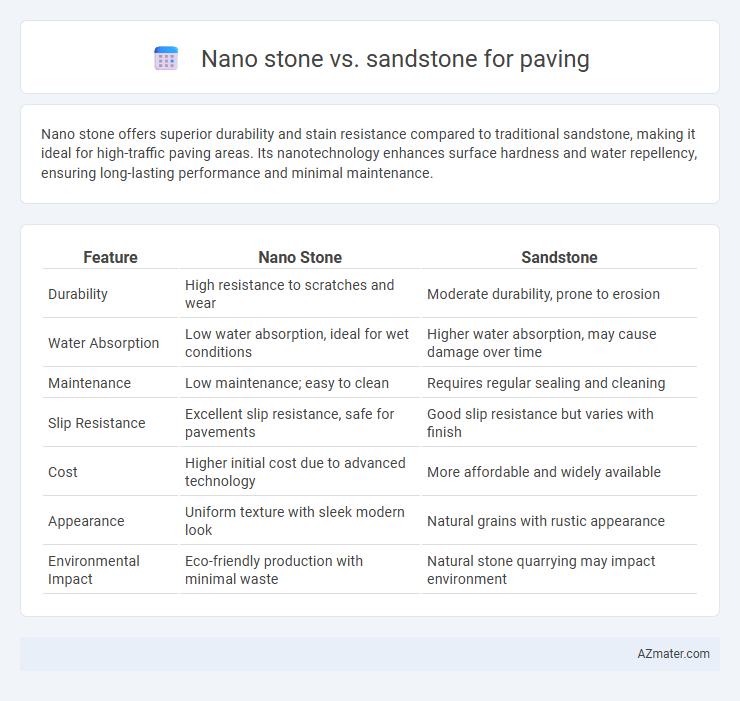Nano stone offers superior durability and stain resistance compared to traditional sandstone, making it ideal for high-traffic paving areas. Its nanotechnology enhances surface hardness and water repellency, ensuring long-lasting performance and minimal maintenance.
Table of Comparison
| Feature | Nano Stone | Sandstone |
|---|---|---|
| Durability | High resistance to scratches and wear | Moderate durability, prone to erosion |
| Water Absorption | Low water absorption, ideal for wet conditions | Higher water absorption, may cause damage over time |
| Maintenance | Low maintenance; easy to clean | Requires regular sealing and cleaning |
| Slip Resistance | Excellent slip resistance, safe for pavements | Good slip resistance but varies with finish |
| Cost | Higher initial cost due to advanced technology | More affordable and widely available |
| Appearance | Uniform texture with sleek modern look | Natural grains with rustic appearance |
| Environmental Impact | Eco-friendly production with minimal waste | Natural stone quarrying may impact environment |
Introduction to Nano Stone and Sandstone for Paving
Nano stone paving offers superior durability and stain resistance due to its engineered composition of finely ground minerals bonded with advanced resins, making it ideal for high-traffic outdoor areas. Sandstone paving, a natural sedimentary rock, provides unique textures and warm earthy tones but is more porous and prone to weathering compared to nano stone. Selecting between nano stone and sandstone depends on factors like maintenance preferences, aesthetic goals, and environmental exposure.
Composition and Structure Comparison
Nano stone paving consists of ultra-fine particles bonded with advanced polymers, creating a dense, non-porous surface that resists staining and weathering. Sandstone, a natural sedimentary rock, is composed mainly of quartz and feldspar grains cemented by silica or calcium carbonate, resulting in a more porous and softer texture. The compact structure of nano stone offers superior durability and low maintenance compared to the more permeable and fragile composition of sandstone.
Durability and Longevity
Nano stone paving exhibits superior durability due to its advanced nanotechnology coating, which enhances resistance to scratches, stains, and weathering compared to traditional sandstone. Sandstone, while naturally robust and aesthetically pleasing, is more porous and susceptible to erosion and discoloration over time under heavy foot traffic and adverse weather conditions. The longevity of nano stone paving significantly surpasses sandstone, making it a more cost-effective and low-maintenance option for long-term outdoor applications.
Aesthetic Appeal and Design Versatility
Nano stone offers a sleek, uniform finish with enhanced color consistency, providing modern aesthetic appeal ideal for minimalist and contemporary paving designs. Sandstone features natural variations in texture and hue, delivering a warm, rustic charm that complements traditional and eclectic landscapes. Both materials exhibit strong design versatility, but nano stone's precision cutting allows for intricate patterns, while sandstone's organic appearance supports more naturalistic, freeform layouts.
Slip Resistance and Safety
Nano stone offers superior slip resistance compared to traditional sandstone, making it a safer choice for paving in wet or high-traffic areas. The advanced micro-textured surface of nano stone enhances grip, reducing the risk of slips and falls. Sandstone, while aesthetically pleasing, tends to become more slippery when wet, decreasing its safety performance in outdoor paving applications.
Maintenance Requirements
Nano stone paving requires minimal maintenance due to its enhanced durability and resistance to stains, scratches, and weathering, reducing the need for frequent cleaning and sealing. Sandstone, while visually appealing, is more porous and prone to wear, necessitating regular sealing and cleaning to prevent damage from moisture and dirt buildup. Choosing nano stone ensures long-term cost savings and ease of upkeep compared to the more maintenance-intensive sandstone paving.
Cost Analysis and Value for Money
Nano stone offers a higher initial cost compared to traditional sandstone, but its durability and low maintenance requirements provide better long-term value for money. Sandstone is more affordable upfront but may incur additional expenses due to its susceptibility to weathering and frequent sealing needs. Evaluating cost analysis reveals that investing in nano stone paving can reduce overall lifecycle costs, making it a cost-effective choice for durable and aesthetically appealing outdoor surfaces.
Environmental Impact
Nano stone paving offers a significantly lower environmental impact compared to traditional sandstone by utilizing advanced nanotechnology that reduces resource extraction and energy consumption during production. Its enhanced durability and resistance to weathering decrease maintenance frequency, minimizing the environmental footprint over its lifespan. Sandstone quarrying often leads to habitat disruption and higher carbon emissions, making nano stone a more sustainable choice for eco-conscious paving projects.
Installation Process and Ease
Nano stone paving offers a streamlined installation process due to its lightweight and uniform size, allowing for quicker placement and minimal surface preparation compared to traditional sandstone. Sandstone requires more extensive groundwork and skilled labor because of its varying thickness and natural irregularities, which can complicate leveling and alignment. The ease of handling nano stone reduces overall labor costs and installation time while maintaining durability suitable for high-traffic areas.
Best Applications for Nano Stone vs Sandstone
Nano stone offers exceptional durability and resistance to scratches and stains, making it ideal for high-traffic commercial and residential paving areas where longevity and low maintenance are crucial. Sandstone provides a natural, textured surface with excellent slip resistance, suited for outdoor patios, garden pathways, and decorative landscaping in moderate-traffic zones. Selecting nano stone is best for modern urban environments requiring sleek aesthetics and robustness, while sandstone excels in rustic, natural settings prioritizing visual warmth and grip.

Infographic: Nano stone vs Sandstone for Paving
 azmater.com
azmater.com